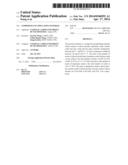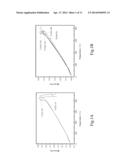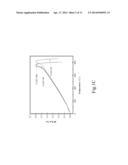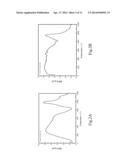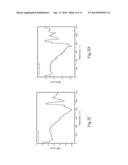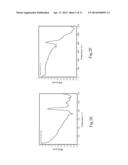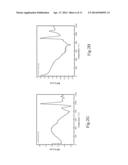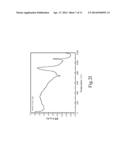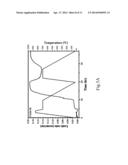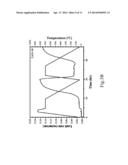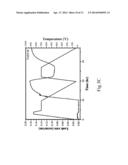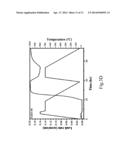Patent application title: COMPOSITE ENCAPSULATING MATERIAL
Inventors:
Sea-Fue Wang (Taipei, TW)
Sea-Fue Wang (Taipei, TW)
Chieh-Sheng Cheng (Taipei, TW)
Yung-Fu Hsu (New Taipei, TW)
Assignees:
NATIONAL TAIPEI UNIVERSITY OF TECHNOLOGY
IPC8 Class: AH01M802FI
USPC Class:
501 15
Class name: Glass compositions, compositions containing glass other than those wherein glass is a bonding agent, or glass batch forming compositions enamels, glazes, or fusion seals (e.g., raw, fritted, or calcined ingredients) fusion seals (frit plus material other than glass)
Publication date: 2014-04-17
Patent application number: 20140106955
Abstract:
The present invention is a composite encapsulating material which
consists of silicon dioxide, aluminum oxide, yttrium oxide and zinc oxide
and has glass transition temperature between 694° C. and
833° C. as well as expansion coefficient between 7.0 and
8.5×10-6/° C. The ratio of the number of moles of
silicon dioxide plus aluminum oxide (yttrium oxide or zinc oxide) to the
total number of moles is 41.88˜62.22% (10.48˜26.67% or
11.11˜47.64%); the ratio of the number of moles of aluminum oxide
to the total number of moles is 5.23˜17.78%. The ratios of aluminum
oxide to silicon dioxide, yttrium oxide to silicon dioxide, and zinc
oxide to silicon dioxide are 0.14˜0.40, 0.29˜0.60, and
0.25˜1.30, respectively.Claims:
1. A composite encapsulating material consists of silicon dioxide,
aluminum oxide, yttrium oxide and zinc oxide.
2. The composite encapsulating material according to claim 1 wherein said composite encapsulating material's glass transition temperature is between 694 and 833.degree. C.
3. The composite encapsulating material according to claim 1 wherein said composite encapsulating material's expansion coefficient is between 7.0 and 8.5.times.10.sup.-6/° C.
4. The composite encapsulating material according to claim 1 wherein said number of moles of silicon dioxide plus aluminum oxide (yttrium oxide or zinc oxide) accounts for 41.88.about.62.22% (10.48.about.26.67% or 11.11.about.47.64%) of a total number of moles.
5. The composite encapsulating material according to claim 2 wherein said number of moles of aluminum oxide accounts for 5.23.about.17.78% of a total number of moles.
6. The composite encapsulating material according to claim 1 wherein said aluminum oxide and said silicon dioxide keep a ratio between 0.14 and 0.40, said yttrium oxide and said silicon dioxide between 0.29 and 0.60, and said zinc oxide and said silicon dioxide between 0.25 and 1.30.
7. The composite encapsulating material according to claim 1 wherein said composite encapsulating material further allows a glass additive, bismuth yttrium oxide herein, to be added.
8. The composite encapsulating material according to claim 7 wherein said glass additive and said composite encapsulating material keep a weight ratio of 1:1.
Description:
BACKGROUND OF THE INVENTION
[0001] 1. Field of the Invention
[0002] The present invention relates to a composite encapsulating material, particularly a composite encapsulating material consisting of oxides.
[0003] 2. Description of the Prior Art
[0004] In the fuel cell technology, Solid Oxide Fuel Cell (SOFC) has advantages such as high transfer efficiency, diversified fuel sources, and lower material cost. However, SOFC featuring high operating temperature (600° C.˜800° C.) demands a high-temperature encapsulation technology which is based on fluid glass-based encapsulating materials to fill gaps between SOFC and a substrate and insulate fuel gas from oxygen for airtight joint. For a fluid encapsulating material, glass transition temperature should be adjusted in the range of 600° C.˜800° C., operating temperature of SOFC.
[0005] In practice, materials used in SOFC are usually operated at high temperature. The materials experience cycles from to high temperature between normal startup and stop, so that some characteristics among different components such as matching attribute and heat stability are critical. Accordingly, an encapsulating material should be effective in a buffer action to reduce any stress-induced damage to one component out of expansion and contraction.
[0006] Shou-Guo Huang et al. disclosed Si--Al--Y--Ba--B glass in Journal of Alloys and Compounds wherein the ratios of various oxides are: silicon dioxide (3.53 wt %; 6.97 mol %), aluminum oxide (7.21 wt %; 8.39 mol %), yttrium oxide (10 wt %; 5.27 mol %), barium oxide (60 wt %; 46.55 mol %), and boron oxide (19.26 wt %; 32.83 mol %). As one material to encase connecting plates between components, this type of glass with boron and alkaline earth elements mixed may result in chemical compounds including cesium, magnesium, barium and calcium, which change an expansion coefficient and cause breaks between composite materials and connecting plates, as well as other chemical compounds on cathode of SOFC due to chemical reactions of alkaline earth elements deteriorating resistivity of SOFC operating at high temperature for a long time. On the other hand, heat stability of glass chronically used will be deteriorated in spite of lowered viscosity and increased wettability of boron oxide added glass due to addition of boron oxide which is characteristic of a low melting point and volatility but causes generation of boron hydroxide.
SUMMARY OF THE INVENTION
[0007] The object of the present invention is to provide a composite encapsulating material consisting of silicon dioxide, aluminum oxide, yttrium oxide and zinc oxide. The composite encapsulating material has glass transition temperature from 694° C. to 833° C. and an expansion coefficient between 7.0 and 8.5×10-6/° C.
[0008] The ratio of the number of moles of silicon dioxide plus aluminum oxide (yttrium oxide or zinc oxide) to the total number of moles is 41.88˜62.22% (10.48˜26.67% or 11.11˜47.64%). Moreover, the ratio of the number of moles of aluminum oxide to the total number of moles is 5.23˜17.78%.
[0009] Furthermore, the ratios of aluminum oxide to silicon dioxide, yttrium oxide to silicon dioxide, and zinc oxide to silicon dioxide are 0.14˜0.40, 0.29˜0.60 and 0.25˜1.30, respectively.
[0010] The other object of the present invention is to provide a composite encapsulating material comprising the above composite encapsulating material and an extra glass additive, i.e., bismuth yttrium oxide (Bi1.5Y0.5O3) wherein the weight ratio of the glass additive to the above composite encapsulating material is 1:1 and the expansion coefficient of the composite encapsulating material with the extra glass additive added is between 9×10-6/° C. and 11×10-6/° C.
[0011] It can be seen from the above descriptions that the present invention has advantages such as better air impermeability, lower softening temperature and easier compression than other encapsulating materials based on the prior art and does not use lead, boron or alkaline earth elements which result in loss of components and environmental pollution.
[0012] These features and advantages of the present invention will be fully understood and appreciated from the following detailed description of the accompanying Drawings.
BRIEF DESCRIPTION OF THE DRAWINGS
[0013] FIG. 1A illustrates curves of thermal expansion coefficients for YAS1-50 and YAS1-25 of the present invention.
[0014] FIG. 1B illustrates curves of thermal expansion coefficients for YAS4-130, YAS4-120, YAS4-100 and YAS4-50 of the present invention.
[0015] FIG. 1C illustrates curves of thermal expansion coefficients for YAS5-100, YAS5-90 and YAS5-50 of the present invention.
[0016] FIG. 2A illustrates the curve of differential thermal analysis of glass for YAS1-25 of the present invention.
[0017] FIG. 2B illustrates the curve of differential thermal analysis of glass for YAS1-50 of the present invention.
[0018] FIG. 2C illustrates the curve of differential thermal analysis of glass for YAS4-50 of the present invention.
[0019] FIG. 2D illustrates the curve of differential thermal analysis of glass for YAS4-100 of the present invention.
[0020] FIG. 2E illustrates the curve of differential thermal analysis of glass for YAS4-120 of the present invention.
[0021] FIG. 2F illustrates the curve of differential thermal analysis of glass for YAS4-130 of the present invention.
[0022] FIG. 2G illustrates the curve of differential thermal analysis of glass for YAS5-50 of the present invention.
[0023] FIG. 2H illustrates the curve of differential thermal analysis of glass for YAS5-90 of the present invention.
[0024] FIG. 2I illustrates the curve of differential thermal analysis of glass for YAS5-100 of the present invention.
[0025] FIG. 3A illustrates relationships of measured leak rates of encapsulated SOFC for YAS4-50 of the present invention.
[0026] FIG. 3B illustrates relationships of measured leak rates of encapsulated SOFC for YAS1-50 of the present invention.
[0027] FIG. 3C illustrates relationships of measured leak rates of encapsulated SOFC for YAS5-50 of the present invention.
[0028] FIG. 3D illustrates relationships of measured leak rates of encapsulated SOFC for YAS5-90 of the present invention.
[0029] FIG. 4 illustrates curves of thermal expansion coefficients for the present invention with Bi1.5Y0.5O3 added.
DETAILED DESCRIPTION OF THE PREFERRED EMBODIMENT
[0030] Table 1 illustrates various ratios of compositions in the present invention of a composite encapsulating material.
TABLE-US-00001 TABLE 1 Al2O3/ Y2O3/ ZnO/ SiO2 Al2O3 Y2O3 ZnO SiO2 SiO2 SiO2 YAS1-50 40.00 16.00 24.00 20.00 0.40 0.60 0.50 YAS1-25 44.44 17.78 26.67 11.11 0.40 0.60 0.25 YAS4-130 36.65 5.23 10.48 47.64 0.14 0.29 1.30 YAS4-120 38.04 5.44 10.87 45.65 0.14 0.29 1.20 YAS4-100 41.18 5.88 11.76 41.18 0.14 0.29 1.00 YAS4-50 51.86 7.40 14.81 25.93 0.14 0.29 0.50 YAS5-100 37.50 12.50 12.5 37.50 0.30 0.30 1.00 YAS5-90 39.00 13.00 13.00 35.00 0.30 0.30 0.90 YAS5-50 46.16 15.38 15.38 23.08 0.30 0.30 0.50
[0031] Referring to FIGS. 1A, 1B and 1C which illustrate curves of thermal expansion coefficients for the present invention, each of which has a turning pointing with a slope abruptly changing at glass transition temperature (Tg) ranging from 694° C. to 833° C. as shown in Table 2, wherein FIG. 1A, FIG. 1B, FIG. 1C are the results of curves of thermal expansion coefficients for YAS1-50 and YAS1-25; YAS4-130, YAS4-120, YAS4-100 and YAS4-50; YAS5-100, YAS5-90 and YAS5-50, respectively. It can be seen from Table 2 that glass transition temperature is effectively reduced with zinc oxide (ZnO) added, for instance, the minimum ratio of ZnO and the maximum ratio of ZnO are observed in YAS4-130 and YAS1-25, respectively. The maximum thermal expansion coefficient expressed with a linear slope is observed in YAS1-50. According to ratios of yttrium oxide to silicon dioxide as shown in Table 1, an expansion coefficient is getting bigger as more yttrium oxide is added due to strong capability of yttrium oxide to cut a network structure. Furthermore, an expansion coefficient is further increased with zinc oxide added (FIG. 1).
TABLE-US-00002 TABLE 2 Thermal Expansion Coefficient Tg (×10-6/° C.) (° C.) Al2O3/SiO2 Y2O3/SiO2 ZnO/SiO2 YAS1-50 8.06 833 0.40 0.60 0.25 YAS1-25 8.17 797 0.40 0.60 0.50 YAS4-130 7.04 748 0.14 0.29 0.50 YAS4-120 7.51 710 0.14 0.29 1.00 YAS4-100 7.59 699 0.14 0.29 1.20 YAS4-50 7.72 694 0.14 0.29 1.30 YAS5-100 7.01 757 0.30 0.30 0.50 YAS5-90 7.29 717 0.30 0.30 0.90 YAS5-50 7.33 713 0.30 0.30 1.00
[0032] Referring to FIG. 2A to 2I which illustrate curves of differential thermal analyses of glass for the present invention wherein an exothermic peak, i.e., crystallization peak of glass, which corresponds to crystallization temperature (Tc) of glass, is detected as temperature increases. FIG. 2A, 2B, 2C, 2D, 2E, 2F, 2G, 2H, 2I are the results of differential thermal analysis on YAS1-25, YAS1-50, YAS4-50, YAS4-100, YAS4-120, YAS4-130, YAS5-50, YAS5-90 and YAS5-100, respectively. According to data summarized in Table 3, crystallization temperature of glass is further lowered with more zinc oxide added. SOFC which features its heat stability affected by crystallization temperature of glass SOFC may lose its original properties and have lowered heat stability when crystallized glass is generated because of glass transition temperature lower than operating temperature of SOFC for a long period.
[0033] Referring to FIGS. 3A, 3B, 3C and 3D which illustrate measured leak rates of encapsulated SOFC at 700° C. wherein FIGS. 3A, 3B, 3C and 3D are the results of measured leak rates of encapsulated SOFC on YAS4-50, YAS1-50, YAS5-50 and YAS5-90, respectively. It can be seen from measured leak rates in FIG. 3 that the lowest leak rate is observed in YAS1-50 (thermal expansion coefficient=8.17×10-6/° C.) and YAS5-50 (thermal expansion coefficient=7.01×10-6/° C.), each of which has a thermal expansion coefficient significantly different from the range of 9˜11×10-6/° C., thermal expansion coefficient of SOFC in operation. Accordingly, a powder-based glass additive (Bi1.5Y0.5O3) which has a larger thermal expansion coefficient is compounded into YAS1-50 and YAS5-50, respectively; the present invention is mixed with the glass additive (Bi1.5Y0.5O3) according to a weight ratio of 1:1.
TABLE-US-00003 TABLE 3 Tc (° C.) YAS1-50 946 YAS1-25 975 YAS4-130 822 YAS4-120 827 YAS4-100 852 YAS4-50 926 YAS5-100 896 YAS5-90 904 YAS5-50 977
[0034] Referring to FIG. 4 which illustrates curves of thermal expansion coefficients for the present invention with the glass additive (Bi1.5Y0.5O3) added wherein thermal expansion coefficients of YAS1-50 and YAS5-50 are increased to 9.47×10-6/° C. and 9.30×10-6/° C., respectively. As shown in FIG. 4, the addition of glass additive (Bi1.5Y0.5O3) contributes to not only increase of a thermal expansion coefficient but also matching between an encapsulating material and other components.
[0035] Many changes and modifications in the above described embodiment of the invention can, of course, be carried out without departing from the scope thereof. Accordingly, to promote the progress in science and the useful arts, the invention is disclosed and is intended to be limited only by the scope of the appended claims.
User Contributions:
Comment about this patent or add new information about this topic:

